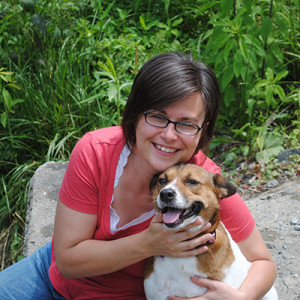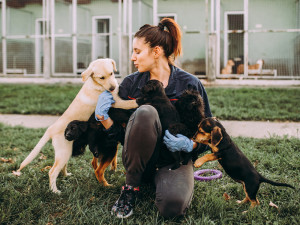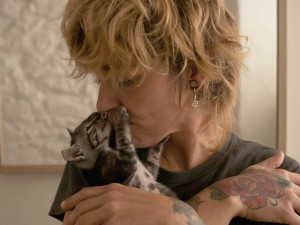Should You Take an Adoptable Pet For a Test Drive?
Some animal rescues allow trial runs for interested adopters. Get the scoop on how foster-to-adopt programs work.

Share Article
After an extensive meet-and-greet that included sloppy kisses, a game of fetch, and lots of cuddles, you are in love. But you also have questions: Will this adorable hound mix sleep through the night? Make a good running partner? Howl at the neighbors? Get along with the resident cat? Adopting a pet is a long-term commitment, and you want to make sure you get it right. That’s why shelters and rescue groups often allow trial adoptions (also called foster-to-adopt programs) to help interested adopters determine if the pet is the right fit for their homes and lifestyles.
“Foster-to-adopt also helps potential adopters who are unsure about adopting a dog — especially with puppies and people who are first time dog adopters — see if a dog is a good fit for them,” says Maddie Swab, dog foster manager for Austin Pets Alive! Below, more on how to get started with a trial adoption.

littleKin™ is Kinship’s home just for puppy and kitten parents. Bop over to check out expert advice, new pet tools, and special deals—all curated for your newest family member.
opens in a new tabHow do foster-to-adopt programs work?
Ask your local shelter whether there is an established program. Remember, even when a shelter offers trial adoptions, not all animals are eligible. Most foster-to-adopt programs will require you to complete an adoption application, which can include information about your living situation, current pets and vet references. Once the shelter reviews and approves the application, you’ll be eligible to take a pet home on a trial basis. Some shelters charge adoption fees up front that can be refunded if the animal is returned within the trial period.
How long do trial adoptions last?
The timeframe to make a decision ranges from a week to a few months, depending on the shelter. Some shelters even offer weekend sleepovers. Austin Pets Alive! limits trial adoptions to one week for puppies but allows up to three weeks to allow prospective adopters to decide whether to adopt a dog with medical challenges. “Often, dogs who have medical or behavioral challenges benefit from their potential adopter getting the chance to see if the challenge is something they can work with in their home,” Swab explains.
How should I prepare for a trial adoption?
Make sure you have all the supplies your four-legged houseguest needs to feel safe and welcomed, including food, bowlsopens in a new tab, and a leash, collar or harnessopens in a new tab. You may also want to have a comfy bedopens in a new tab and a few toys on handopens in a new tab to help them settle in. If you will be fostering-to-adopt a puppy or dog that is not housebroken, you should consider a crateopens in a new tab or puppy penopens in a new tab. If a cat, a litter boxopens in a new tab and litter. Swab also encourages potential adopters with existing pets to schedule a meet-and-greet at the shelter to introduce pets where shelter staff can monitor interactions and offer pointers on welcoming a new pet, even temporarily.
What should I be looking for during the trial adoption?
Consider a trial adoption a working interview for the position of loving, four-legged companion. The process should let you know whether you want to bring the animal into your home on a full-time basis.
Does the dog enjoy being in the center of the action when the kids are running around the house or do they hide from the activity and noise? Are your morning and evening walkopens in a new tabs enough to burn off their energy or do you need to hire a dog walkeropens in a new tab, or send them to doggie daycareopens in a new tab, to satisfy their exercise and socialization needs? Is the cat a total snuggle bug or do they hiss when you try to show them affection?
What do I need to remember?
It takes time for dogsopens in a new tab and cats to adjustopens in a new tab to a new environment, which means that their behavior on the first day — or even in the first week — may not be an indication of their true personalities. Swab advises giving pets time to decompressopens in a new tab and letting them settle in at their own pace.
Shelter staff are there to act as a resource, so don’t be afraid to ask questions during the trial adoption, especially if you need more time to make a decision. “We will sometimes consider extending the foster-to-adopt period as needed to give that dog and the potential adopter the best chance to get to know each other and see if they’re a good fit for each other,” Swab adds.
What if it’s not a fit?
Not all trial adoptions are success stories. If you discover that the dog or cat that has been bunking with you for several days isn’t the right fit for your family, don’t fret. Spending time in a home environment helps animals decompress, which is a bonus even when it doesn’t lead to an adoption. Trial adoptions also give adoption coordinators more information about pets, including insights into their behavior in a home environment, that can be beneficial when it comes to finding them the right forever family.
If your trial adoption goes well, encourage others to participate in similar programs. “Fosters, who provide temporary homes for puppies, dogs, kittens or cats, give shelter pets an opportunity to live in a home, instead of a kennel at a shelter,” she explains. “Some might call their foster-to-adopt pets ‘foster fails,’ but we think of them as ‘foster wins,’ as another dog or cat has found a loving home.”

Jodi Helmer
Jodi Helmer is a North Carolina-based freelance writer who shares her home with an embarrassing number of rescue dogs and relies on four feral cats to patrol the barn. When she isn’t refilling food and water dishes, Jodi writes about animals for Scientific American, Sierra, WebMD, AKC Family Dog, Living the Country Life, and Out Here.
Related articles
![Woman holding dogs at an animal shelter]() opens in a new tab
opens in a new tab10 Ways Animal Shelters Are Upping Their Game
New trends we can totally get behind.
![Blonde woman with hand tattoo kissing her gray kitten]() opens in a new tab
opens in a new tabA Step-by-Step Guide to Adopting a Cat
From where to begin looking to what the adoption process entails to how to prepare your home for your new pet.
![Dog standing in an animal shelter]() opens in a new tab
opens in a new tab“Should I Adopt an Adult Rescue Dog?”
Yes! Shelters are full of good, grown-up doggos. Here’s how to find the perfect match.
![A dog at a shelter looking up at the camera.]() opens in a new tab
opens in a new tab10 Questions to Ask a Shelter About an Adoptable Dog
From exercise needs to medical history to compatibility with kids, here is everything you need to know.




